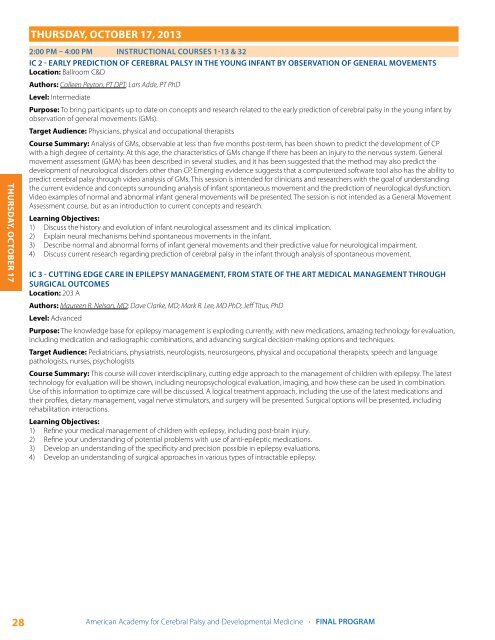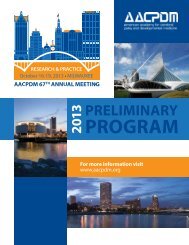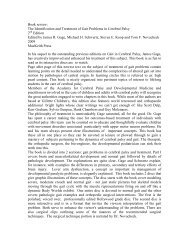ProgrAm - American Academy for Cerebral Palsy and ...
ProgrAm - American Academy for Cerebral Palsy and ...
ProgrAm - American Academy for Cerebral Palsy and ...
- No tags were found...
Create successful ePaper yourself
Turn your PDF publications into a flip-book with our unique Google optimized e-Paper software.
Thursday, October 17, 2013THURsday, October 172:00 pm – 4:00 pm Instructional Courses 1-13 & 32IC 2 - EARLY PREDICTION OF CEREBRAL PALSY IN THE YOUNG INFANT BY OBSERVATION OF GENERAL MOVEMENTSLocation: Ballroom C&DAuthors: Colleen Peyton, PT DPT; Lars Adde, PT PhDLevel: IntermediatePurpose: To bring participants up to date on concepts <strong>and</strong> research related to the early prediction of cerebral palsy in the young infant byobservation of general movements (GMs).Target Audience: Physicians, physical <strong>and</strong> occupational therapistsCourse Summary: Analysis of GMs, observable at less than five months post-term, has been shown to predict the development of CPwith a high degree of certainty. At this age, the characteristics of GMs change if there has been an injury to the nervous system. Generalmovement assessment (GMA) has been described in several studies, <strong>and</strong> it has been suggested that the method may also predict thedevelopment of neurological disorders other than CP. Emerging evidence suggests that a computerized software tool also has the ability topredict cerebral palsy through video analysis of GMs. This session is intended <strong>for</strong> clinicians <strong>and</strong> researchers with the goal of underst<strong>and</strong>ingthe current evidence <strong>and</strong> concepts surrounding analysis of infant spontaneous movement <strong>and</strong> the prediction of neurological dysfunction.Video examples of normal <strong>and</strong> abnormal infant general movements will be presented. The session is not intended as a General MovementAssessment course, but as an introduction to current concepts <strong>and</strong> research.Learning Objectives:1) Discuss the history <strong>and</strong> evolution of infant neurological assessment <strong>and</strong> its clinical implication.2) Explain neural mechanisms behind spontaneous movements in the infant.3) Describe normal <strong>and</strong> abnormal <strong>for</strong>ms of infant general movements <strong>and</strong> their predictive value <strong>for</strong> neurological impairment.4) Discuss current research regarding prediction of cerebral palsy in the infant through analysis of spontaneous movement.IC 3 - CUTTING EDGE CARE IN EPILEPSY MANAGEMENT, FROM STATE OF THE ART MEDICAL MANAGEMENT THROUGHSURGICAL OUTCOMESLocation: 203 AAuthors: Maureen R. Nelson, MD; Dave Clarke, MD; Mark R. Lee, MD PhD; Jeff Titus, PhDLevel: AdvancedPurpose: The knowledge base <strong>for</strong> epilepsy management is exploding currently, with new medications, amazing technology <strong>for</strong> evaluation,including medication <strong>and</strong> radiographic combinations, <strong>and</strong> advancing surgical decision-making options <strong>and</strong> techniques.Target Audience: Pediatricians, physiatrists, neurologists, neurosurgeons, physical <strong>and</strong> occupational therapists, speech <strong>and</strong> languagepathologists, nurses, psychologistsCourse Summary: This course will cover interdisciplinary, cutting edge approach to the management of children with epilepsy. The latesttechnology <strong>for</strong> evaluation will be shown, including neuropsychological evaluation, imaging, <strong>and</strong> how these can be used in combination.Use of this in<strong>for</strong>mation to optimize care will be discussed. A logical treatment approach, including the use of the latest medications <strong>and</strong>their profiles, dietary management, vagal nerve stimulators, <strong>and</strong> surgery will be presented. Surgical options will be presented, includingrehabilitation interactions.Learning Objectives:1) Refine your medical management of children with epilepsy, including post-brain injury.2) Refine your underst<strong>and</strong>ing of potential problems with use of anti-epileptic medications.3) Develop an underst<strong>and</strong>ing of the specificity <strong>and</strong> precision possible in epilepsy evaluations.4) Develop an underst<strong>and</strong>ing of surgical approaches in various types of intractable epilepsy.28<strong>American</strong> <strong>Academy</strong> <strong>for</strong> <strong>Cerebral</strong> <strong>Palsy</strong> <strong>and</strong> Developmental Medicine • FINAL PROGRAM







